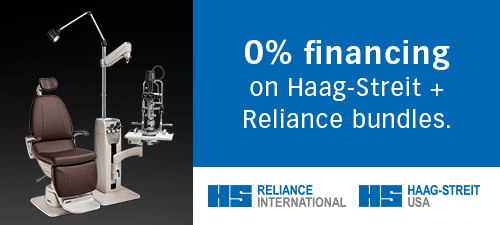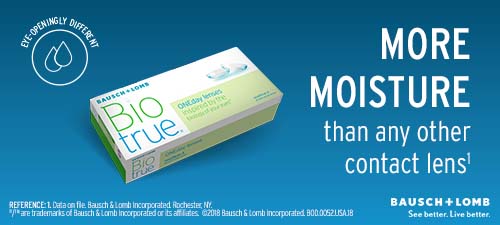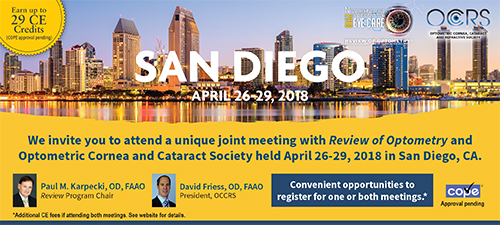
A
weekly e-journal by Art Epstein, OD, FAAO
Off the Cuff: Homeostasis
Tucked neatly into the DEWS II definition of dry eye is perhaps the single most important word in the paragraph: homeostasis. Understanding how the normal eye works is key to understanding how to get it back on track when things go awry. The more I immerse myself in dry eye, the more obvious it becomes that I will never fully understand the complexity of the ocular surface environment. One thing I do understand is that, given an opportunity, the eye’s surface will always try to fix itself. As with the rest of our bodies, the means to accomplish repair are baked in. As the elegance of the tears and complexity of the ocular surface environment become increasingly apparent to me as a clinician, I realize that our patients’ signs and symptoms are not just caused by any single factor, but rather, by a systematic failure of function and repair. Describing this as a loss of homeostasis may well be the biggest step in the right direction toward understanding “dry eye” that we’ve taken in quite some time.
|
|||||
|
|||
| Scanning Behavior and Daytime Driving Performance of Older Adults with Glaucoma | ||||
This study assessed the link between visual scanning behavior and closed-road driving performance in older drivers with glaucomatous visual impairment. Participants included 13 older drivers with glaucoma (mean age=72.0±6.7 years; average better-eye mean deviation [MD])=-2.9±2.1 dB, average worse-eye MD=-12.5±7.1 dB) and 10 visually normal controls (mean age=70.6±7.4 y). Visual acuity, contrast sensitivity, visual fields, useful field-of-view (UFoV) and motion sensitivity were assessed. Participants drove around a closed-road circuit while their eye movements were recorded with an ASL Mobile Eye-XG, and head movements were recorded using the gyroscope sensors of a smart phone. Measures of driving performance included hazards hit, sign recognition and lane-crossing time; an overall driving score was derived from these component measures. Participants with glaucoma had significantly poorer overall driving scores and hit more hazards than controls. The glaucoma group also exhibited larger saccades, and greater horizontal and vertical search variances than controls. Larger saccades were associated with better driving scores in the glaucoma group, but not the controls. Head movements did not differ between groups. For all participants, better-eye MD was the strongest visual predictor of overall driving score, followed by the other measures of visual fields, motion sensitivity, contrast sensitivity and UFoV. Older drivers with glaucoma had poorer driving performance than controls and demonstrated differences in eye movement patterns. Researchers wrote that the association between larger saccades and better driving scores in those with glaucoma suggested that altering scanning behavior might benefit driving performance and safety in this group. |
||||
SOURCE: Lee SS, Black AA, Wood JM. Scanning behaviour and daytime driving performance of older adults with glaucoma. J Glaucoma. 2018; Apr 2. [Epub ahead of print]. |
||||

|
||
| The Role of Corneal Hysteresis During the Evaluation of Patients with Possible Normal-tension Glaucoma | ||||
Several reports of the role of corneal hysteresis (CH) as an independent risk factor for the diagnosis and risk of progression of normal-tension glaucoma (NTG) exist. Investigators measured CH with the Ocular Response Analyzer (ORA) in patients with intraocular pressure (IOP) <21mm Hg to investigate if a low CH would identify NTG, as part of a prospective cross-sectional study of patients who underwent routine eye examination during 2016 in a private practice in Honolulu, Hawaii, where most patients are Asian.
Inclusion criteria were: ≥65 years, IOP<21 (compensated IOP by ORA) and CH values<10 using ORA as measured by a single experienced technician. Exclusion criteria were: sight-limiting ocular or corneal disease that would preclude accurate measurements for the purposes of the study, any patient who had difficulty in being tested with the ORA and patients who had any history of any type of glaucoma. All patients that met the inclusion criteria underwent fundus photography to measure cup-to-disc ratio and cup-to-disc asymmetry, and had central corneal thickness measured. Thickness of the retina nerve fiber layer was measured by ocular coherence tomography. The eyes with an average retina nerve fiber layer thickness less than 80μm were classified as possible NTG and scheduled for a visual field test. The field examination was considered valid only if the fixation, false positives and false negatives were within the acceptable range. Patient demographics and data on preexisting diseases were collected including age, sex, coexisting medical conditions and previous intraocular surgery. Those with thinning of retina nerve fiber layer on optical coherence tomography had a Humphrey visual field test to confirm the diagnosis of glaucoma. Seventy-six eyes of 46 patients that met the eligibility criteria were included in the study. Twenty-one previously undiagnosed eyes were confirmed as having NTG, corresponding to an incidence of 27.6%. Investigators concluded that CH measurement was a valuable test to assist in the early diagnosis of NTG, especially in an elderly Asian population. They suggested that aggressive early treatments (medically or surgically to further lower IOP) could prevent irreversible blindness in established diagnosis. |
||||
SOURCE: Chen M, Kueny L, Schwartz AL. The role of corneal hysteresis during the evaluation of patients with possible normal-tension glaucoma. Clin Ophthalmol. 2018;12:555-9. |
||||

|
||
| The Effect of Fish Consumption on Macula Structure and Function of Healthy Individuals: An OCT and Mferg Study | ||||
This study was designed to investigate the potential effect of fish consumption on macular structure and function in healthy individuals. The participants, of Greek heritage, were used to consuming less than one portion of fish per week since childhood. All participants underwent body mass index (BMI) measurements and ophthalmological examinations. At their first examinations, they were asked to consume at least two portions of fish per week over a period of eight weeks, after which all the measurements were repeated.
Eighteen healthy individuals (36 eyes) participated in this study. The central macular thickness was reduced, while the amplitudes in foveal and parafoveal areas were increased after fish consumption. However, all measurements remained within the normal range at both visits. Researchers determined that regular fish consumption might enhance the structural and functional status of the macula. |
||||
SOURCE: Moschos MM, Nitoda E, Lavaris A, et al. The effect of fish consumption on macula structure and function of healthy individuals: an OCT and mfERG study. Eur Rev Med Pharmacol Sci. 2018;22(5):1203-8. |
||||

|
||
| News & Notes | ||||||||
| Vision Care Expert Launches Educational Resource for Myopia To help better manage myopia, Thomas Aller, OD, FBCLA, a national expert on the disease, has launched an educational and informational website, ManageMyopia.org. The clinically reviewed resource summarizes the latest data on myopia so that management of the disease is easier for busy eye care professionals to find, analyze and apply. The website features the latest data highlights from research and peer-reviewed journals on leading-edge therapies for myopia, with a focus on evidence-based clinical data, practical treatment options and hands-on management strategies. Read more. |
||||||||
| Coburn Introduces New VF Analyzer & Retinal Camera to Product Line Coburn Technologies introduced two new products—the SK-850A Visual Field Analyzer and SK-650A Retinal Camera. The analyzer is an automatic pure optical projection perimeter designed with full compliance with the Goldman standard. All features (including auto gaze tracking and auto calibration) are designed according to international standards, and provide a quantitative evaluation of the retina macula function. The retinal camera is non-mydriatic and DICOM compatible. Key features include auto mosaic function and optical red-free testing. Read more. |
||||||||
| Avedro Celebrates 10-year Anniversary Avedro is celebrating 10 years of scientific research, innovation and business. Since its founding in 2008, Avedro has grown from a small R&D company to an internationally recognized ophthalmic pharmaceutical and medical device company, and a leader in corneal remodeling. Important accomplishments, among others, were the introductions of therapies for individuals with progressive keratoconus, including: Photrexa Viscous (riboflavin 5’-phosphate in 20% dextran ophthalmic solution), Photrexa (riboflavin 5’-phosphate ophthalmic solution) and the KXL System epi-off corneal crosslinking treatment. Read more. |
||||||||
| 2018 ARVO Student Travel Fellowship Recipients Announced The American Academy of Optometry released the names of recipients of the 2018 Student Travel Fellowship Awards. The fellowships enable allow six students to present their research at the Association for Research in Vision and Ophthalmology 2018 annual meeting. The 2018 recipients include: (Supported by Johnson and Johnson and The Vision Care Institute) • Jessica Jasien, University of Alabama Birmingham, School of Optometry • Daisy Shu, BOptom(Hons)/BSci, University of New South Wales, School of Optometry and Vision Science • Laura Pardon, OD, MS, FAAO, University of Houston, College of Optometry • Katie Bales, University of Alabama Birmingham, School of Optometry • Hannah Burfield, University of Houston, College of Optometry (Supported by the American Academy of Optometry) • Billie Beckwith-Cohen, DVM, MBA, FAAO, University of California Berkeley, School of Optometry Applications for student travel fellowships for the Academy’s annual meeting, Academy 2018 San Antonio, will be available in July 2018. For more information visit http://www.aaopt.org/students/stf |
||||||||
| IDOC Offers a New IDOC Select Contact Lens Plan IDOC introduced a new membership plan, with the release of the IDOC Select Contact Lens Plan. Beginning April 2, IDOC members will have access to the new plan in addition to the existing one. This choice makes it easier for ODs to access the membership benefits of their contact lens business, with flexibility to continue on with an existing preferred lab provider. As with the existing plan, Alcon and CooperVision are exclusive manufacturers. ODs have access to a range of resources and tools that support accelerated practice growth, including: • Share-based vendor rebates, with no growth required to be rebate eligible •Real-time data and analytics technology for fact-based decision-making • Customized, expert business advice from a team of experienced practice management consultants • Networking opportunities with industry peers at interactive workshops and national educational events • A dedicated account manager to help maximize membership opportunities Read more. |
||||||||
|
||||||||
|
Optometric Physician™ (OP) newsletter is owned and published by Dr. Arthur Epstein. It is distributed by the Review Group, a Division of Jobson Medical Information LLC (JMI), 11 Campus Boulevard, Newtown Square, PA 19073. HOW TO ADVERTISE |



